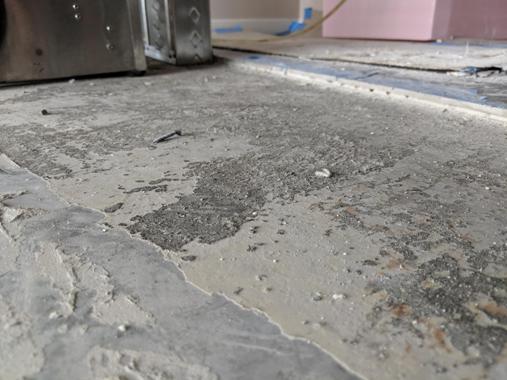Beautiful tile installations don’t just happen. They require adequate substrate preparation, a detailed layout plan, and accomplished tile setting and grouting skills with true attention to detail. But to make all of this happen, a properly-prepared substrate is crucial for thin-set mortar to bond correctly.
A thorough site visit is needed to determine the condition of the concrete substrate whether it be new or existing. You may think that new construction would be adequate, but what if the concrete has been treated with a curing compound? It looks okay and it seems to be clean. Or, what if the job is to be installed over an existing substrate which is contaminated with a latex adhesive, a black cut-back emulsion, or paint overspray? Is it good to go?
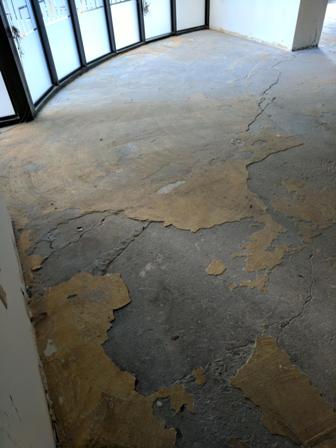

Image # 1 displays a combination of poorly-prepared concrete, self-leveling underlayment (SLU) without the required primer, and two layers of latex carpet glue. (Also note the significant crack in the concrete which also must be addressed prior to the installation of tile). Most times the best job would be achieved if the contaminants are properly and completely removed.
Basically, there are three methods to rid the surface of the bond breaker: a citrus or solvent-based cleaner; grinding or sanding; some type of equipment used to mechanically alter or scarify the substrate.
Pros and cons of substrate prep methods
The cleaner may appear to remove the contaminant, but many times it actually liquefies it, driving it further into the concrete. The result may render the substrate unsuitable for an adequate bond.
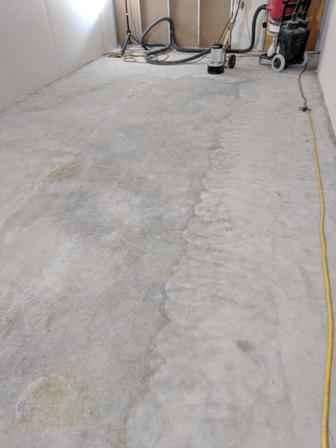

Image #2 -Thin layers of latex carpet adhesive can be effectively removed by using a heavy-duty floor grinder equipped with the appropriate grinding head.Photo courtesy of Nichols Tile & Terrazzo Co., Inc.
Scarifying can be a broad term employed to describe the method which mechanically alters the concrete substrate by removing the contaminant. Depending on the type of contaminant, the removal process may need to go a 1/4” or more in depth to effectively remove the problem. Since these methods remove a portion of the concrete surface, silica dust is created and can become harmfully airborne. The methods listed be can and should employ HEPA filtered vacuum systems to safely contain and remove the residue.
There are four ways to accomplish the desired result which are listed in an increasingly aggressive order.
- Grinders – Surface grinding or sanding as seen in image # 2, can effectively remove a thin layer of latex glue. However, the removal of thicker layers of old adhesive can be problematic. The heat generated by the grinding can turn the glue back into a liquid which sinks deeper into the concrete as was mentioned above. This method also gums up the sandpaper or grinding wheel making them quickly ineffective. Additionally, the grinding doesn’t always abrade or open up the concrete surface, but rather, this action can actually polish the surface which will inhibit a good bond with most thin set mortars. Always check the substrate porosity by pouring a small amount of water on the surface to determine if it will be adequately absorbed, indicating a potentially adequate bond.
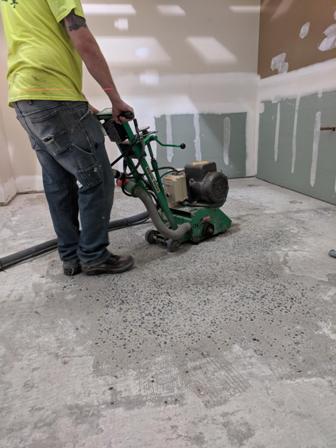

- Shot blasters – A shot blaster uses steel shot that is propelled onto the floor surface at a high rate of speed. This ‘shot gun’ effect pulverizes the top layer of concrete, usually about 1/8” to 3/16”, to effectively remove paint overspray, latex adhesives, concrete curing compounds, and dirt. The result is a dry roughened texture which, when properly cleaned, is ready to receive thin set mortar or an SLU.
- Scarifiers – Scarifiers — also known as milling machines or surface planers as seen in image # 3 — remove the concrete surface more aggressively than grinders or shot blasters by use of high-speed rotating cutting wheels or drums containing hardened steel or carbide tips that hammer or pummel the substrate. This action can be adjusted to merely shave the surface or more aggressively remove up to 1/4″ of the surface in one pass which leaves a rough surface that may contain ridges as seen in image # 4. This surface can be an excellent base for an SLU product, but may not be suitable for thin set mortar without additional patching. Scarifiers may also be used to flatten or possibly level uneven surfaces.
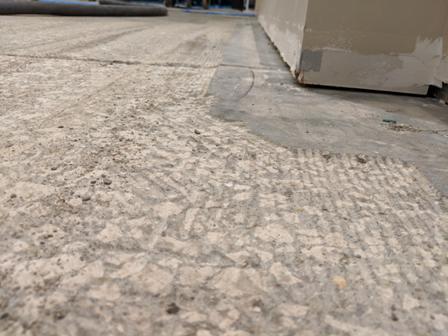

Scabblers – Scabblers are designed to roughen the concrete even more effectively than grinders, shot blasters, or scarifiers. Powered by compressed air, gas, or electricity, the carbide-tipped bits mounted on multiple pistons efficiently hammer the surface at over one thousand times per minute. This action can be extremely noisy, but it is able to remove 1/4” of surface material in a single pass and can also remove high spots as well as break up and remove existing ceramic tile and mortar.
All of the methods mentioned can do a great job, but it takes experience and wisdom to select the method that will meet the desired goal of a flat (and possibly level) surface which will readily and effectively bond ceramic and porcelain tile for many years of lasting beauty.


Scott Carothers
Scott Carothers is the Acdemic Director for the Ceramic Tile Education Foundation (CTEF) and is responsible for the creation of the Certified Tile Installer (CTI) program, and is involved in the creation of the Advanced Certifications for Tile Installers (ACT) program as well as providing training to others in the tile industry.
Carothers has been involved in the ceramic tile industry for nearly 40 years and was the owner of a successful retail and installation firm prior to CTEF. He has served as President and Chairman of the Board of the National Tile Contractors Association (NTCA), Chairman of the NTCA Technical Committee, was named the NTCA Tile Person of the Year in 2005, and the NTCA Ring of Honor recipient in 2013. He is a voting member of the ANSI and the TCNA Handbook committees.


